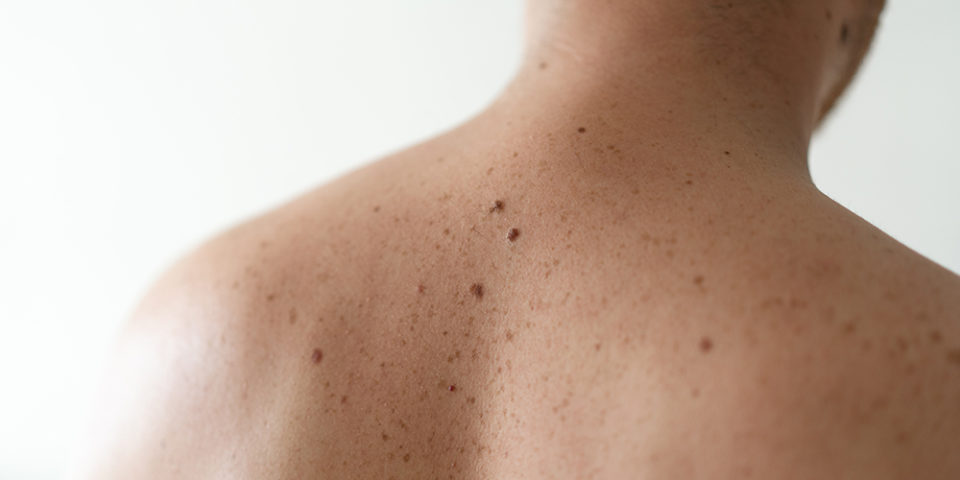How to tell if a mole is cancerous
Skin cancer is the most common cancer to affect adults in the U.S., and the American Academy of Dermatology believes 1 in 5 Americans will develop skin cancer in their lifetime. How can you tell if a mole is cancerous and what can you do to prevent skin cancer? Dermatologist Charles Darragh, MD, said it starts with knowing what to look for and when to speak with a physician about skin spots or moles that cause concern.
What do cancerous moles look like?
“Cancerous moles come in a wide variety of shapes and colors,” Dr. Darragh explained. “We often speak with patients about the ‘ABCDEs’ of melanoma to help them know what is unusual to see in a mole and how to tell if a mole is cancerous, or might be.”
The ABCDEs of skin cancer include:
- A for Asymmetry – Moles are generally symmetrical in shape, meaning both sides are the same. If one side is very light and the other dark, or the shape is very different on one side versus the other, this would be an example of an asymmetrical mole.
- B for Border Irregularity – A normal mole generally has a well-defined border. A mole with a scalloped or poorly defined border would be considered irregular.
- C for Color – Healthy moles tend to be uniform in color. Does the mole include multiple shades of brown from very dark to very light, or include reds, blues, or whites all within one area?
- D for Diameter – If the mole is larger than the size of a pencil eraser (about 6 millimeters), it may need evaluation.
- E for Evolving – Has the mole recently changed color? Has it grown? Is it significantly different than the other moles on your body? Did it originally have a solid, uniform border but recently has become uneven around the edges? All of these could be a sign of skin cancer. Any change in a mole is worth a closer look.
If your moles show any of these characteristics, it’s best to have them checked out by a board-certified dermatologist.
“I personally take the most stock in moles that are changing and evolving,” Dr. Darragh said. “I often tell patients that if you notice an ‘ugly duckling’ mole, one that doesn’t look like the others, to please give us a call. It can be difficult to know how to tell if a mole is cancerous on your own.”
What are some other signs of skin cancer?
The two most common types of skin cancer are basal cell carcinoma and squamous cell carcinoma. Both are found most often on sun-exposed areas like the face, scalp, arms and hands.
Skin cancer lesions of these types will typically first show as new growths or bumps that don’t go away. They may bleed, grow further, ulcerate, and never heal.
“One thing I hear a lot from patients is that they initially thought they were dealing with acne or a cyst,” Dr. Darragh said. “As time goes on, this ‘bump’ never went away, it kept growing, perhaps bled a little.”
Not all growths will be cancerous or malignant. Non-dangerous growths will usually not hurt or bleed and will heal with time. If you’ve noticed a bump that is new, isn’t healing, bleeds or is painful, schedule an appointment with a dermatologist.
What are some risk factors for skin cancer?
The number one risk factor for skin cancer, by far, is ultraviolet sun exposure.
This could be through chronic sun exposure – those who work outdoors may be especially susceptible – or through intermittent sun exposure.
Other risk factors include:
- Fair skin that resists tanning
- Blue or hazel eyes
- Blond or red hair
- A tendency to sunburn
- Repeated use of tanning beds
- Already having numerous moles (more than 100)
Patients who are immunosuppressed are also at a higher risk for skin cancers.
How can you prevent skin cancer?
The best method of preventing skin cancer is to avoid sun exposure. A few easy lifestyle changes can help keep your skin safe and healthy without sacrificing time outdoors. Avoid the sun in the summer when UV rays are strongest (typically between 11 a.m.– 3 p.m.).
When spending time in the sun, it is essential to wear sunscreen or sun protective clothing. “We recommend applying 1 ounce of broad-spectrum sunscreen (about the same amount as a shot glass) every 90 minutes to two hours when out in the sun,” Dr. Darragh said. “If you go swimming, reapply more often than that, as even water-resistant sunscreen can wash away with time.”
Broad-spectrum sun protection protects against both UVA and UVB rays. SPF 15 works well for general day-to-day life, but you’ll be better protected during prolonged sun exposure with SPF 30 or above. When choosing sun-protective clothing, make sure it has an SPF rating of at least 30.
Wear long sleeves if you can. Wearing a hat can also help shade your face from the rays of the sun, but you should still always use sunscreen as well.
Find the care you need, close to home
Our primary care physicians provide well visits and everyday care when you need it with compassion and expertise.
Find Primary Care Near You

